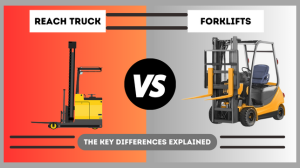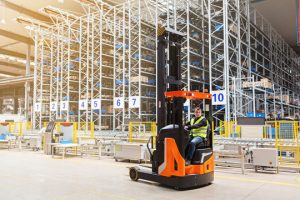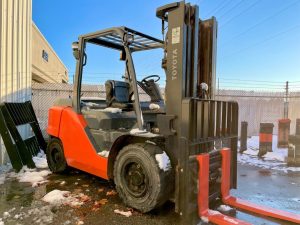In the world of material handling and warehousing, the forklift and reach truck are two essential pieces of equipment. Both play pivotal roles in the smooth operation of warehouses, manufacturing plants, and other industrial settings. But despite their common purpose of lifting and transporting goods, they are far from identical.
In this comprehensive article, we will delve into the unique features, benefits, and limitations of each. We aim to provide you with a clear understanding of these two machines, enabling you to make an informed decision when it comes to choosing the right equipment for your specific needs.

What is a Reach Truck?
A reach truck is a type of industrial equipment designed specifically for warehouse use. It’s named after its ability to ‘reach’ beyond the confines of the machine itself, extending its forks into racking or shelving to pick up or place loads.
This unique characteristic makes it a versatile tool in narrow aisle applications, maximising storage space and increasing efficiency. In the following sections, we will delve deeper into its features, uses, and benefits, helping you understand why it might be the ideal choice for certain environments.

Find Your Perfect Forklift
Compare Quotes from Local Forklift Dealerships


Enter Requirements


We Find the Best Deal


Receive your Quote
What is a Forklift Truck?
A forklift truck, also commonly referred to as a lift truck or forklift, is a powered industrial truck used to lift, move, and place heavy objects over short distances. It’s an essential piece of equipment in many industries, including warehousing, construction, and manufacturing.

What’s the Difference Between a Reach Truck and a Forklift?
Reach trucks and forklifts are both essential pieces of machinery designed for handling materials. However, they have distinct capabilities and features that make them suitable for different tasks and environments. These key differences can be broken down into several categories:
Use Cases
Forklifts are known for their versatility, finding applications in a wide range of settings from construction sites and lumber yards to warehouse operations. Their robust design and diverse attachment options allow them to handle a myriad of tasks beyond just lifting.
In contrast, reach trucks are specifically optimised for indoor environments, particularly warehouses. Their superior lift heights and compact design make them ideal for navigating narrow aisles and stacking goods on high racks.
Design
The design of a machine plays a crucial role in its functionality and efficiency. A reach truck tends to have a smaller, more compact design with a slimmer chassis. This allows it to navigate tight spaces, particularly in narrow warehouse aisles. It also has extendable forks that can reach loads situated deep within racks. Furthermore, reach trucks usually feature two outer legs that distribute the load weight, enhancing stability during operations.
On the other hand, forklifts have a more robust, larger design and weigh more, suitable for carrying heavier loads. The forks on a forklift protrude from the front and do not extend like those on a reach truck, allowing forklifts to approach the load directly and lift it. Forklifts are often built to endure harsher environments, such as outdoor construction sites, making them more versatile in different use cases.
Load Balancing
Reach trucks are designed to balance loads by retracting the load towards the machine’s wheelbase. This unique design feature helps maintain stability during operations. Conversely, forklifts utilise a counterbalance approach where the weight of the vehicle itself is used to offset the load, ensuring balanced and safe handling of materials.
Lifting Capacity
Forklifts usually have a much greater lifting capacity than reach trucks, enabling them to handle heavier loads. This makes them particularly suitable for tasks that require transporting substantial weights, while reach trucks are better suited for lighter loads in more confined spaces.
Fuel Types
Both reach trucks and forklifts can be powered by a variety of fuel types, including diesel, gasoline, propane, and electricity. However, reach trucks are predominantly electric-powered due to their indoor usage and the need for low emissions and noise levels. In contrast, forklifts, which often operate outdoors, may use any of the mentioned fuels depending on the specific model and application requirements.
Lifting Heights
Reach trucks are often favoured for their superior lifting heights, thanks to their extendable forks. This unique design feature makes them particularly well-suited for stacking goods onto towering warehouse racks, significantly optimising vertical storage space.
Attachments
Forklifts generally provide a larger number of possible attachments in comparison to reach trucks. This versatility increases their functionality, enabling them to handle a diverse array of tasks beyond simple lifting and transporting, thereby enhancing their value in various operational contexts.
Operator Controls
The controls for operating a forklift and a reach truck differ significantly due to their distinct functionalities. Forklifts typically have a more straightforward control scheme, with levers for lifting and lowering loads, and a steering wheel for navigation.
Reach trucks, on the other hand, often require more complex controls due to their extendable forks and higher lift capabilities. Operators might need to manage additional buttons or levers to extend or retract the forks, adjust the tilt, and control the elevation. The complexity of the controls reflects the specialised tasks each vehicle is designed to perform.
Turn Radius
Reach trucks are designed with a significantly smaller turn radius compared to forklifts, giving them a distinct advantage in navigating compact spaces. This feature, often reducing the turn radius by up to 35%, enhances their manoeuvrability, particularly in confined areas such as narrow warehouse aisles. Consequently, reach trucks are a go-to choice for operations that require precise handling in space-constrained environments.
The Benefits and Limitations of Reach Trucks
Benefits of Reach Trucks
- High Reach: Reach trucks are designed to reach heights that traditional forklifts can’t, making them suitable for high rack storage in warehouses.
- Manoeuvrability: Their small turn radius allows them to navigate tight spaces and narrow aisles with ease.
- Safety: Reach trucks often include advanced safety features, such as camera systems for better visibility at height and operator protection systems.
- Efficient Space Utilisation: They can stack pallets closer together than a standard forklift, increasing warehouse storage capacity.
- Less Floor Damage: Reach trucks typically have cushion tires, which cause less damage to warehouse floors compared to the pneumatic tires used by many forklifts.
Limitations of Reach Trucks
- Indoor Use Only: Reach trucks are primarily designed for indoor use. They’re not suitable for rough terrains or outdoor conditions.
- Limited Load Capacity: While reach trucks can lift higher, they generally have a lower load capacity compared to traditional forklifts.
- Requires Skilled Operators: The complex controls of a reach truck require well-trained operators for safe and efficient operation.
- Higher Maintenance Costs: Due to their specialised design and advanced features, reach trucks may have higher maintenance costs.
- Battery Life: As most reach trucks are electric, their battery life and charging time could limit their operational hours.
The Benefits and Limitations of Forklift Trucks
Benefits Of Forklifts
- Versatility: Forklifts are incredibly versatile, capable of handling a wide range of tasks beyond just lifting and moving pallets.
- Higher Load Capacity: Compared to reach trucks, forklifts generally have a higher load capacity, making them suitable for heavy-duty operations.
- Indoor and Outdoor Use: Forklifts can operate both indoors and outdoors, including on rough terrains, unlike reach trucks that are primarily designed for indoor use.
- Variety of Models: There are various models of forklifts, each designed for specific tasks and environments. This allows businesses to find a model that perfectly suits their needs.
- Attachment Options: Forklifts often offer a variety of attachment options, further increasing their versatility.
Limitations Of Forklifts
- Large Turning Radius: Forklifts generally have a larger turning radius than reach trucks, which can make them less manoeuvrable in tight spaces.
- Lower Reach: While forklifts can lift heavy loads, they typically cannot reach as high as reach trucks, limiting their effectiveness in high rack storage situations.
- Safety Concerns: Operating a forklift can pose safety risks if not handled properly. They can tip over if the load is not properly balanced or if driven recklessly.
- Space Requirements: Due to their size, forklifts require more space for operation and storage, which can be a limitation in space-constrained environments.
- Noise and Emissions: Gas-powered forklifts can produce noise and emissions, making them less suitable for indoor environments compared to electric alternatives.
Which Is More Suitable For Your Requirements, A Reach Truck Or A Forklift?
The choice between a reach truck and a forklift largely depends on your specific needs and the factors discussed earlier. Here’s an overview of where each truck would work best:
Reach Trucks are best for:
- Locations where smaller and more agile machine than forklifts are required.
- Use in narrow aisle applications, like warehouses.
- Use with lighter loads that need to be moved to a certain height..
Forklifts are best for:
- Tasks requiring the lifting and moving of heavier loads.
- When use of a rear weight is needed for balance.
- When the ground or terrain is uneven.
- When operations require frequent outdoor use.
In conclusion, the most suitable equipment – reach truck or forklift – varies based on the specific operational needs, the layout of your workspace, and the nature of the loads you handle. It’s best to consider all these factors before making a decision.
Final Thoughts
The decision between a reach truck and a forklift relies heavily on your specific operational needs, the layout of your workspace, and the nature of the loads you handle.
In order to make an informed decision, it is crucial to match these factors against your unique requirements. But how can you find the best equipment that meets your needs?
Forkify, an online platform for comparing quotes from local dealers for reach trucks and forklifts, is a great resource. Simply input your requirements and let Forkify find the most suitable options for you. This not only saves time but also ensures you get the best value for your investment!